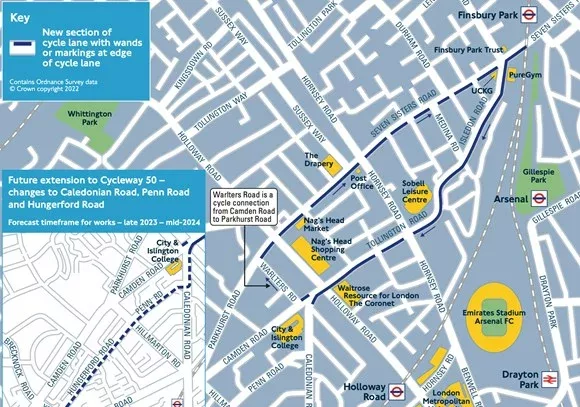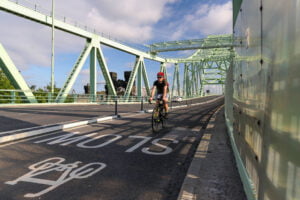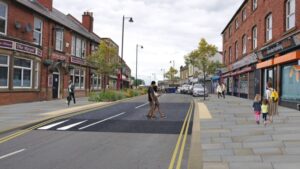Transport for London (TfL) has confirmed that construction work will begin on a new cycle route between Finsbury Park and Holloway Road on 20 February. The new section of Cycleway 50 will be the first along a major new corridor of safer walking and cycling infrastructure and will be a significant boost to London’s growing network of high-quality Cycleways. The new route, which includes an overhaul of the intimidating and outdated Nag’s Head gyratory, will deliver much-needed improvements to roads and junctions and make it easier for everyone in the area to travel in a healthy, sustainable and affordable way.
Previous analysis carried out by TfL has shown that the Camden to Finsbury Park corridor is within the top five per cent in London with the greatest potential for increasing the number of people cycling, and one of the top ten for travel to and from central London. Creating enough space for people to walk and cycle safely is vital to a sustainable transport network, especially as around 60 per cent of households in inner London do not have access to a car, with a high proportion of these from low-income households.
The new sections of Cycleway 50 will connect people in neighbourhoods along two new segregated cycle lanes, running westbound along Seven Sisters Road and eastbound along Isledon Road and Tollington Road. There is currently no cycling infrastructure at the Nag’s Head gyratory near Holloway Road, or connections into the existing cycle network, making it difficult for people to make longer trips. Collision data also shows that 31 people cycling and 53 people walking were injured at the gyratory between June 2017 and June 2020 and the route forms part of the Mayor’s Vision Zero commitment to eliminate death and serious injury on the transport network.
Work will be carried out in phases between February and December this year. Work carried out as part of the scheme will also make it easier to walk in the area, with upgraded pedestrian crossings and extra space for people walking along the route. Speed limits along the route will be reduced to 20mph.
The Cycleway will be built as an experimental route and a full consultation on the scheme will begin once construction is complete. Further sections of the Cycleway could begin construction later this year, connecting the Nag’s Head gyratory and Holloway Road with York Way via Hungerford Road. This section would connect to an existing cycle route to Royal College Street, making it even easier for people to make journeys across north London and beyond by cycle.
Will Norman, London’s Walking and Cycling Commissioner, said: ”More Londoners than ever are choosing to walk and cycle around the capital. We need to continue to make London’s roads safer and journeys easier by building more high-quality cycling infrastructure.
“This new cycleway between Finsbury Park and Holloway will be yet another step towards making cycling easier and more appealing to people in the capital, and help build a safer, fairer and greener London for everyone.
Mike Hardaker, TfL’s Director of Capital Delivery, said: “We’re determined to make cycling in London safer and easier and this major new route is a key part of our plans to expand London’s growing network of high-quality Cycleways. We know how important safer cycling infrastructure at this location is to people in the borough and beyond and are delighted to be able to confirm the start of construction work here.
“We’re building this Cycleway as an experimental route and will be working closely with Islington Council to make sure the changes support everyone in the area to travel more sustainably. I’d like to thank residents in the area for their patience during construction work and would encourage people in the area to check their journeys before they travel.”
Cllr Rowena Champion, Islington Council’s Executive Member for Environment, Air Quality, and Transport, said: “It’s critically important that we work to tackle the climate emergency, especially as Islington is one of the six London boroughs most at risk to climate change.
“We’ve already taken great strides towards creating a cleaner, greener, healthier Islington for all, by creating streets where people can safely and easily walk, cycle, scoot, and use buggies and wheelchairs.
“We know, though, that we must go further. That’s why we’ve been working with TfL on plans for Cycleway 50, which will make it easier for local people to walk, cycle, and wheel between Finsbury Park and Holloway Road. The route will make it easier for local people to switch to environmentally friendly modes of transport, especially in Nag’s Head, where there are currently no cycling facilities or links to existing routes. Meanwhile, it will also provide a link to other safe cycling routes, both in Islington and beyond.
“Local people are at the heart of our efforts to transform Islington’s streets, and we’re listening extremely carefully to their feedback. TfL is hosting engagement and consultation on Cycleway 50, and comments from local people will be key to determining the long-term future of the route.”
TfL will continue working closely with London’s boroughs to deliver even more walking and cycling infrastructure in the coming years. TfL announced last autumn that it will restart work on paused schemes to make the capital’s roads safer and more attractive for those walking and cycling, following vital investment being secured as part of the latest funding agreement with Government. Since April last year, TfL and boroughs have delivered 13.8km of new or upgraded cycle routes and there are a further 13.2km in construction. In total, TfL aims to deliver at least 39km of new or upgraded cycle routes over the next 18 months, with the support of boroughs. TfL will also start work on pedestrian and cycling improvements at Streatham High Road and Manor Circus.
TfL’s funding agreement with Government has secured £80m per year to be invested in walking and cycling schemes, with a further £69m per year allocated to boroughs. TfL has so far reduced danger at 43 junctions across London as part of its Safer Junctions programme, with work on at a further two locations set to start this year. All locations in the Safer Junctions programme had higher-than-average collision rates and this improvement work is a vital part of TfL’s Vision Zero ambition.
TfL recently launched local engagement on plans to introduce 28km of new 20mph speed limit on its roads within the boroughs of Camden, Islington, Hackney, Haringey and Tower Hamlets. The new speed limits would help to make a large area of London safer and more attractive for people in these communities to live, work and play, encouraging more people out of their cars to walk, cycle and use public transport.





















